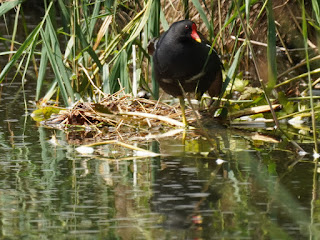A young Chaffinch lurked in the bushes in the leaf yard.
For several days a Chiffchaff has been calling at the southwest corner of the bridge, very hard to see in the trees and bushes. It appeared for a moment on a bramble.
Neil got a good picture of a Robin feeding a fledgling in the Flower Walk. This isn't the young one I photographed on Tuesday, it's farther along to the west.
The female Little Owl near the Round Pond was in her favourite horse chestnut tree ...
... and the female at the Serpentine Gallery in the usual sweet chestnut tree.
Both trees are looking brown and autumnal long before the proper time, the former because of Leaf Miner infestation and the latter simply because of lack or rain. The owlets are getting much harder to find because as they grow up they stop their insistent begging calls.
The female Peregrine was on the barracks tower. I didn't see the male.
Neil made an interesting observation of a Grey Heron with a leech clinging to its face.
The heron managed to shake the leech off, and Neil photographed it. He thinks it is a Duck Leech, Theromyzon tessulatum.
A Great Crested Grebe on the Serpentine -- I think the only one. They have had a terrible year. Three early attempts at breeding all failed because it was too early and there weren't yet enough small fish. The parents must have left in discouragement, but a second attempt would have had more success because there are now plenty of small fish. I have known grebes on the lake to start nesting as late as 1 September.
One of the Coot chicks from the boat platform investigated a leaf.
The Moorhens in the stream in the Dell have built a second nest, as Moorhens often do. I couldn't see any chicks but I think this was simply because they were hidden in the reeds. The parents wouldn't have built a second nest if they had lost their chicks.
A Tufted duckling appeared on the Serpentine today, no doubt the sole survivor of a larger brood.
It's already a week or more old. Probably the nest was on the island. Tufted ducklings have a slightly greater chance of survival than Mallard ducklings because of their ability to dive swiftly and deep.
A family of Egyptian Geese were eating a plant in the shrubbery under the Triangle car park. I didn't know what it was, and looked it up. It's senna, whose pods are used by humans as a laxative -- something certainly not needed by geese.
Another picture by Neil, of a Jersey Tiger Moth. A recent arrival in Britain, this moth is now regularly seen in London.
A Meadow Brown butterfly perched on a heliotrope in the Flower Walk ...
... and a Batman Hoverfly fed on a bachelor's button.


%202022%201.jpg)



%202022%201.jpg)
%202022%201.jpg)




%202022%201.jpg)


That is a remarkable close-up of a wild heron regardless of the leech. Was it AI-enhanced? Jim
ReplyDeleteThere is no such thing as AI enhancement, just a stupid electronic routine fouling things up. This was an honest image taken at a moderate distance with a decent medium-length lens.
DeleteThat Heron was lucky. Amazing picture.
ReplyDeleteVery sad about poor Grebes. What a cruel year this has been so far.
Tinúviel
I don't know how you can shake a leech off. Maybe it had simply finished feeding and let go of its own accord.
Delete